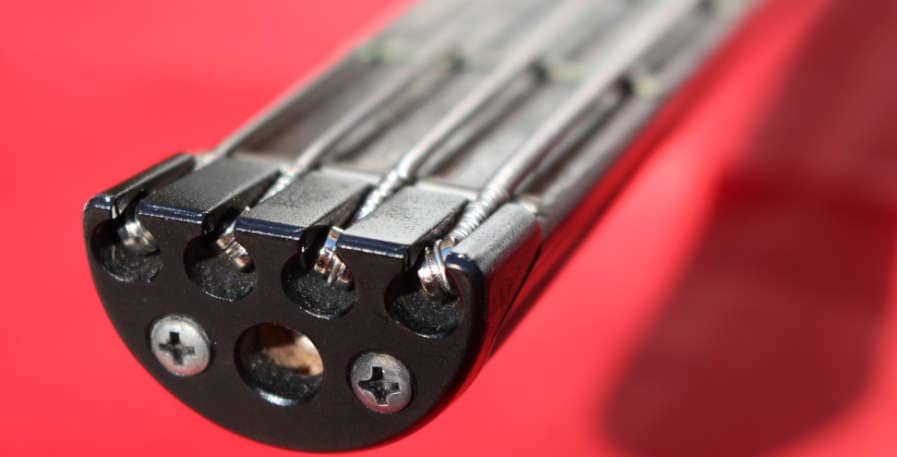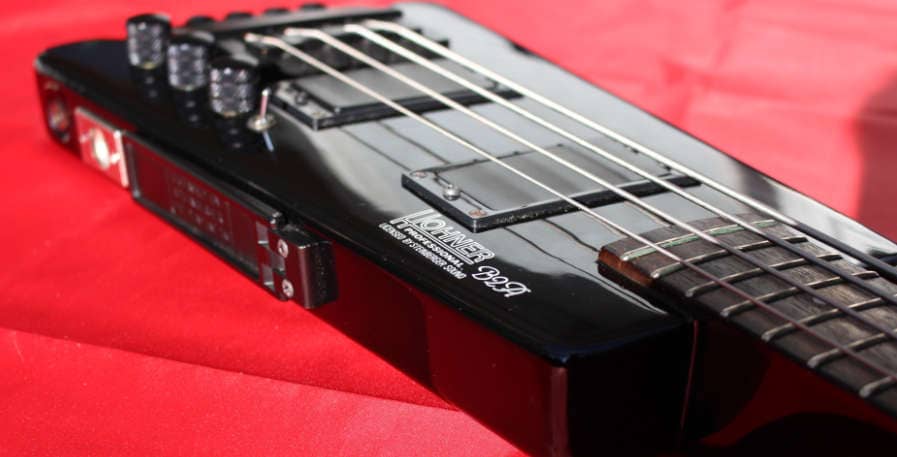While I have yet to own a headless bass guitar, it’s hard to say why. Every time I have tried one I found it to hold several advantages over basses with headstocks. So what makes them different, and what is the point of a headless bass?
Headless basses are stable instruments that stay in tune for longer and are easier to tune than basses with headstocks. They are also lighter than traditional basses, making them easier to travel with. Furthermore, some bassists prefer them because of their unique look.
Maybe I am just too used to the feel of a heavier bass with a headstock. However, If I were to do it all over I would highly consider opting for a headless as my first bass.
In general, bassists tend to be unfamiliar with the headless bass guitar and its pros and cons. So much so, that most of us think of the headstock as one of the most integral parts of the bass. Thus, I decided to write this article to tell you everything about what makes the headless bass different.
What is a headless bass guitar?
Headless bass guitars are characterized by having thumbscrews for tuning at the bridge of the bass. As headless basses lack headstocks, the strings are held in place by nuts behind the top of the neck.
Headless instruments have been around for a long time, but the headless bass guitar as we know it was developed in the 70s.
Leo Fender and Ned Steinberger were the forerunners in bringing the instrument to the mainstream market. To this day, Steinberger and Fender remain some of the most known manufacturers of headless basses.
The headless bass has not gotten close to overtaking basses with headstocks in popularity. Still, they have seen a good bit of mainstream use. Here are just some musicians who have played a headless bass in their careers:
- Geddy Lee of Rush
- John Edwards of Status Quo
- Phil Lesh of The Grateful Dead
- Tina Weymouth of Talking Heads
- Jack Casady of Jefferson Airplane
- Bill Wyman of The Rolling Stones
I`ve never found there to be a drastic difference in tone between headless basses and basses with headstocks. However, they are vastly different in terms of playability and looks.
The advantage of a headless bass
Headless basses are preferred by many bassists because they are easier to tune and because they stay in tune for a longer time. This is due to the shorter string length, and the strings being tuned by pegs at the bridge. Furthermore, the lack of a headstock gives more space to the fretting hand at the lower frets.
Are headless basses better? Some bassists claim that they are. Here are the main advantages of playing a bass without a headstock:
- Tuning- Tuning the bass at the bridge is generally considered easier than with machine heads on a headstock. This makes tuning a headless bass faster and more convenient.
- Stability – Due to the shorter string length and locking mechanism, headless basses stay in tune longer. Having tuning knobs at the bridge is also convenient if you accidentally hit your bass. The chance of hitting the bridge is minimal while the tuning knobs on a headstock are prone to get hit. Especially so when playing on stage.
- Balance – Some conventional basses are poorly balanced. This means that the neck of the bass falls further down than your ideal playing position when the bass is strung onto you. Generally, this is due to the headstock being too heavy. Headless basses, on the other hand, will remain stable against your body.
- Playability – Depending on the headstock, a bass can feel cumbersome to play at the first fret. Headless basses on the other hand do not run into this problem. The lack of a headstock means your thumb and fretting hand can move freely and smoothly at the lowest frets.

The disadvantages of a headless bass
Headless basses generally don`t provide a convenient place to rest your arm due to their thin bodies. Some bassists dislike the lack of a headstock, as they find that their fretting hand can slide away from the neck without it. Others dislike headless bass because of their unconventional design.
So if the instrument is so great, why is not everyone playing a headless bass? Here are the most common reasons:
- Lack of armrest – Headless basses come in many different shapes. Most of them though, have thinner bodies than traditional bass guitars. In particular, it is common to associate the headless basses with the thin classic Steinberger model. The body of this bass is to small to properly rest your arm on it, which can result in playing feeling cumbersome and exhausting.
- Lack of hand support – Similar to lacking support for your fretting hand, the lack of a headstock can result in your fretting hand feeling unsupported. As a result, your fretting hand can slide off the neck when playing a headless bass guitar.
- Design – Some love the look of fretless basses, while others can`t stand it. Still, bassists rarely disregard bass guitars because they are not love in love with their looks if they like the playability. This is not the case when it comes to headless basses. Their aesthetic is by far the most common reason I have heard for bassists staying away from them.
The best headless bass for beginners
If you are looking for a good-quality headless bass that is also affordable, I recommend starting out with the Steinberger Spirit XT-2.
The Steinberger headless bass is what most people think of when they visualize a headless bass guitar. This is no coincidence, as they have become the staple headless bass for a good reason.
It is 38.5″ (98cm) long and 7.5lbs (3.4kg). The light weight allows for smooth playability and makes it a great bass for longer gigs.
It is also a great bass to bring with you, as the hard maple neck makes it less sensitive to temperature changes. Thus, it is a great option if you occasionally have to leave your bass in the car. Furthermore, the size, length, and weight make it an ideal bass to travel with.
The Spirit XT-2 has 1 full-tone HB-1 for the bridge pickup and an HB-2 for the neck pickup. As a result, the bass offers a distinct tone, while still allowing for a good bit of experimentation and customization.
The Steinberger Spirit XT-2 is available on Zzounds. To learn more about the bass, read customer reviews, and view color options, click the button below to visit their site:
Conclusion
As with everything else, whether you choose to play a headless bass guitar or a traditional model comes largely down to preference.
However, the main takeaway here is that the headless basses are not as much of a niche instrument as many believe them to be. The fact that they see significantly less use than basses with headstocks is in large part due to tradition. When all your idols play basses with headstocks, you tend to want to do the same.
If the history of the bass guitar was slightly different, headless basses could very well have been what most people associate with the bass guitar. While this isn’t the case, it is still a great instrument that is very similar to the common bass. There are pros and cons as outlined above, but ultimately there is little difference between playing a headless bass or a bass with a headstock.
That is, except for the looks, which is ultimately the main thing that draws people towards it or away from it.
Another reason headless bass guitars feel great to some bassists is that regular large-scale basses just feel too big. But why are basses so long anyway? I answer this, and what would happen if basses were shorter, in this article: Why are Basses so Long?

